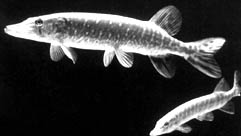Superfish
 thousands of robotic pikes may soon help reveal why fish are so much more efficient at swimming than they should be. The first free-swimming robotic fish is nearing completion at the Massachusetts Institute of Technology ( mit ), usa .
thousands of robotic pikes may soon help reveal why fish are so much more efficient at swimming than they should be. The first free-swimming robotic fish is nearing completion at the Massachusetts Institute of Technology ( mit ), usa .
John Kumph and his colleagues at the department of ocean engineering have built this 80-centimetre-long model of the chain pickerel, a species of pike found in rivers throughout North America. The pike was the obvious choice because of its speed and turning ability.
In building the pike, Kumph drew on earlier work on a robotic tuna, which was tethered to a floating sledge and controlled through cables. But unlike the tuna, the pike will be free-swimming, controlled through a radio in its fibreglass nose cone ( New Scientist , Vol 157, No 2123).
The nose cone is rigid and the pike's skeleton is a spiral fibreglass spring. This makes the body strong and flexible enough to perform a strong swimming stroke. The main thrust comes from the side-to-side movement of the tail fin. This movement is generated by a servomotor pulling on tungsten cables attached to a spine along the backbone of the fish.
Two small servomotors taken from the model aircraft are used to move the pike's pectoral fins and steer it. The fish is weighted so that it swims just below the surface. Tests conducted in 1997 in a 11,0000-litre tank proved that the robopike could swim strongly and turn easily.
All servomotors are located in the rigid nose cone, because the constant flexing of the body could damage them and limit their effectiveness. The skin of the fish is made of Lycra stretched over a steel mesh. This is flexible enough to allow a powerful swimming stroke but strong enough to withstand the water pressure.
Kumph says that the tuna and pike were built to resolve Gray's paradox
